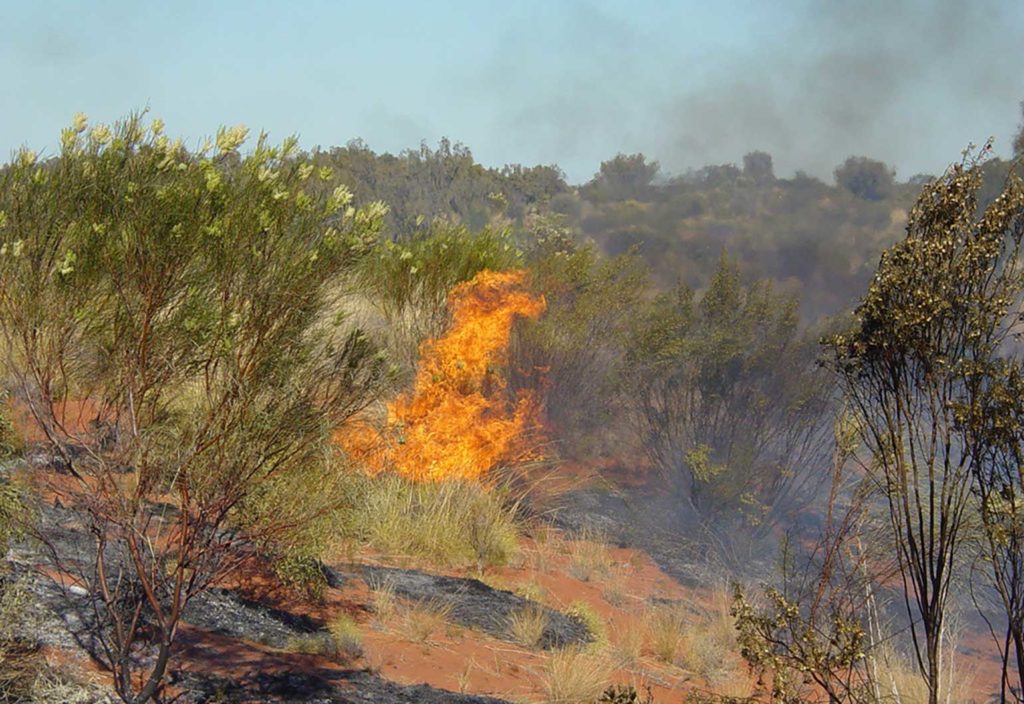The catastrophic bushfires that raged earlier this year sparked interest in Aboriginal fire management and the role it might play in managing fires in Australia.
In his award-winning book The Biggest Estate on Earth, Bill Gammage, a historian and Adjunct Professor in the Humanities Research Centre at the Australian National University, documented how, before colonisation, Aboriginal and Torres Strait Islander people managed the landscape in a sophisticated, scientific and systematic way using fire to prevent damaging bushfires, foster healthy Country and ensure year-round food supply.
Luritja man Chris Croker, a mining engineer and Managing Director at Impact Investment Partners, also sees parallels between science, engineering and cultural burning.
Croker’s family comes from the region around Watarrka (Kings Canyon) west of Alice Springs. He has firsthand experience of cultural burning.
“When I was a kid, I participated in traditional fire management practices,” Croker told create.
“Where I come from, it’s very dry, and we talk about a generation cycle where, each year or two in the cooler months, you burn a small fire in a patchwork pattern – which might be tens of hectares – to help germinate various species of plants, promote vegetation favoured by certain animals, and get rid of the dry vegetation.
“The next year, you move not to the adjacent spot, but the next spot over, and that area will be burnt off. So, over roughly 20 years – one generation – all the country is managed through fire.”
Cool burns
Croker’s example illustrates the way that when and where Country is burnt is based on a deep knowledge of local ecosystems. It also highlights how cultural burning involves small, controlled, low-temperature or “cool” fires that are staggered to create a mosaic pattern in the landscape.
Cultural burns are often referred to as cool burns because they are undertaken when the weather is cool and there is moisture in the ground and air that limits the spread of fires.
Cool fires are gentle on the landscape and burn low to the ground to clear away any build-up of dry vegetation and fallen trees. This prevents hot, uncontrolled fires in the dry months, or lessens the impact if they do occur.
The “cultural” description is a broad term that references how each Aboriginal group across Australia has its own fire-management practices that reflect its cultural practices and values.
These may include using fire to promote the abundance of certain plants or animals that are important to a particular group.
“I understand traditional knowledge of fire practices may be viewed with scepticism,” said Croker.
“But there are underlying engineering and scientific approaches.”
Aboriginal and Torres Strait Islander people view everything in the living world – plants, animals, people – as interconnected. Croker said this view is mirrored in systems engineering.
“Knowledge has been built up not over one or two iterations, but by the local community over thousands of years,” he said.
“It is a scientific method because you have a hypothesis of what is going to change, you see it in action, and then refine it. That’s exactly why the traditional approach should be viewed as a sound, empirical knowledge bank we can trust.”
Traditional approaches
While Croker’s family has been able to carry on traditional fire practices mostly uninterrupted, many Traditional Owners across Australia are prevented from undertaking cultural burns due to colonisation.
The Firesticks Alliance is a national organisation working to change that.
The Alliance empowers local Aboriginal communities to reinstate cultural burning and educates land managers and government agencies through training and mentoring programs, practical workshops, and collaborations with scientists investigating the ecological effects of cultural burning.
Oliver Costello, a Bundjalung man from northern NSW, is the CEO of Firesticks. He said people often struggle to understand the complexity and nuances associated with cultural burning, and much of the alliance’s work is focused on brokering appropriate engagement with Traditional Owners around cultural fire management.
“There are lots of opportunities to collaborate, but we want to have long-term, two-way reciprocal relationships that are aligned and respectful,” Costello said.
“It’s really important First Nations people have authority and hold knowledge about cultural burning. Even if it hasn’t been sustained in practice, it’s still their knowledge because it’s based on their connection to the land. There are important cultural protocols for managing land and we really want local custodians, landholders and government agencies to work together to understand those roles and relationships.”
The way forward
Senior Researcher and Program Manager with Firesticks Dr Peta-Marie Standley is a Cultural Fire Ecologist with a PhD in environment science.
Standley has studied cultural burning for more than 20 years and said more and more studies show cultural burning has a positive effect on biodiversity.
More than 200 years of colonisation means that a return to Bill Gammage’s portrait of Indigenous Australia is impossible, but Standley believes collaboration can help address our current fire challenges.
“I think Western and Indigenous knowledge systems are very different and you can’t simply mash them together, but both are part of the puzzle we are dealing with now in a contemporary, highly modified landscape,” she said.
“The solution is not about cherry-picking bits of Indigenous knowledge we think we can understand readily. I think it’s about working together to have deeper understanding of Indigenous knowledge and practice and having a co-generative dialogue, where Indigenous people are empowered to lead in that space and we are working together on what seems an intractable problem around fire management.”
This article originally appeared as “Fire control” in the March 2020 edition of create magazine.
